KitchenAid KHTU160KSS, KHTU160KBL, KHTU100KBL, KHTU100KSS, KHTU100KWH Installation Instructions
...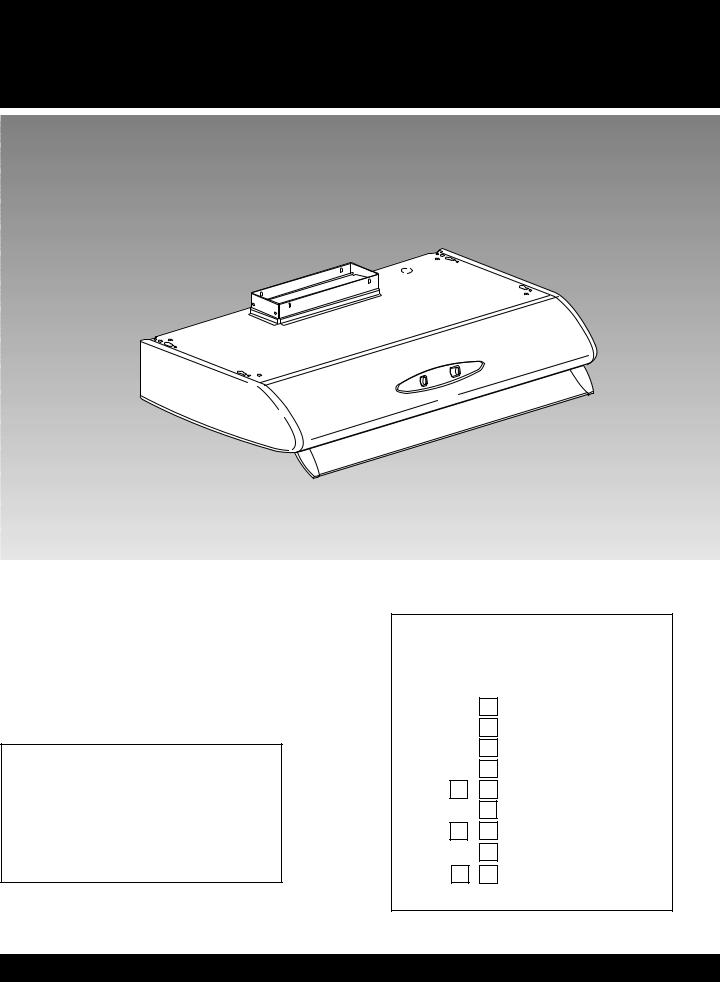
Installation Instructions and
Use and Care Guide
30" (76.2 cm) and 36" (91.4 cm)
Traditional Series Vented and Non-Vented
Range Hoods
KHTU100 Series
Roof-vented model shown.
KHTU160 Series
IMPORTANT:
Read and save these instructions.
IMPORTANT:
Installer: Leave Installation Instructions with the homeowner.
Homeowner: Keep Installation Instructions for future reference.
Save Installation Instructions for local electrical inspector's use.
Quick Reference
Table of Contents:
Pages
2Before you start
2Electrical requirements
3Vent system requirements
3Product dimensions
4 - 6 Installation steps
6Wiring diagram
6 - 7 Use and Care Information
7Warranty
8 - 9 Requesting Assistance
or Service
4329589/9763392

Before you start...
Your safety and the safety of others are very important.
We have provided many important safety messages in this manual and on your appliance. Always read and obey all safety messages.
This is the safety alert symbol.
This symbol alerts you to potential hazards that can kill
or hurt you and others.
All safety messages will follow the safety alert symbol and either the word “DANGER” or “WARNING”. These words mean:
 DANGER
DANGER
You can be killed or seriously injured if you don’t immediately follow instructions.
 WARNING
WARNING
You can be killed or seriously injured if you don’t follow instructions.
All safety messages will tell you what the potential hazard is, tell you how to reduce the chance of injury, and tell you what can happen if the instructions are not followed.
Important: Observe all governing codes and ordinances.
Proper installation is your responsibility:
•Have a qualified technician install this range hood.
•Comply with installation clearances specified on the model/serial rating plate.
If installation is non-vented (recirculating), you must use Non-Vent (recirculating) Kit Part No. 4396273, available from your dealer. The kit fits all models.
The model/serial rating plate is located inside the range hood. To access, remove the grease filters.
Range hood location should be away from strong draft areas, such as windows, doors and strong heating vents.
Grounded electrical connection is required. See “Electrical requirements.”
Important: This hood must be a minimum of 24" (61 cm) above cooking surface.
All openings in ceiling and wall where range hood will be installed must be sealed.
2
Tools and materials needed for installation:
•Phillips head screwdriver
•drill
•1-1/2" (4.0 cm) drill bit
•keyhole saw
•sabre or jig saw
•metal snips
•tape (for template)
•duct tape
•pencil
•ULor CSA-listed 1/2" (12.5 mm) conduit connector (for range hood)
•1 wall or roof cap
•power supply cable (if not previously installed)
•metal vent system (if not previously installed)
Parts supplied:
•four 2-3/4" (7 cm) screws
•four 2" (5.1 cm) screws
•hood installation template
WARNING — TO REDUCE THE RISK OF FIRE, ELECTRIC SHOCK, OR INJURY TO PERSONS, OBSERVE THE FOLLOWING:
Installation work and electrical wiring must be done by qualified person(s) in accordance with all applicable Codes and Standards, including fire related construction. Sufficient air is needed for proper combustion and exhausting of gases through the flue (chimney) of fuel burning equipment to prevent back drafting. Follow the heating equipment manufacturer’s guideline and safety standards such as those published by the National Fire Protection Association (NFPA), and the American Society of Heating Refrigeration and Air Conditioning Engineers (ASHRAE), and the local code authorities.
When cutting or drilling into wall or ceiling, do not damage electrical wiring and other hidden utilities.
Ducted fans must always be vented to the outdoors.
WARNING — To reduce the risk of fire, use only metal ductwork.
This unit must be grounded.
Copies of the standards listed may be obtained from:
*National Fire Protection Association One Batterymarch Park
Quincy, Massachusetts 02269
**CSA International
8501 East Pleasant Valley Road Cleveland, Ohio 44131-5575
Electrical requirements
Important: Observe all governing codes and ordinances.
It is the customer’s responsibility:
•To contact a qualified electrical installer.
•To assure that the electrical installation is adequate and in conformance with National Electrical Code, ANSI/NFPA 70
— latest edition*, or CSA Standards C22.1-94, Canadian Electrical Code, Part 1 and C22.2 No.0-M91 - latest edition** and all local codes and ordinances.
If codes permit and a separate ground wire is used, it is recommended that a qualified electrician determine that the ground path is adequate.
A 120-volt, 60-Hz, AC-only, fused electrical system is required on a separate 15-amp circuit, fused on both sides of the line.
Do not ground to a gas pipe.
Check with a qualified electrician if you are not sure range hood is properly grounded.
Do not have a fuse in the neutral or ground circuit.
IMPORTANT:
Save Installation Instructions for electrical inspector’s use.
The range hood must be connected with copper wire only.
The range hood should be connected directly to the fused disconnect (or circuit breaker) box through flexible armored or nonmetallic sheathed copper cable. Wire sizes (COPPER WIRE ONLY) and connections must conform with the rating of the appliance as specified on the model/serial rating plate.
Wire sizes must conform to the requirements of the National Electrical Code ANSI/NFPA 70 — latest edition*, or CSA Standards C22.1-94, Canadian Electrical Code Part 1 and C22.2 No. 0-M91 - latest edition** and all local codes and ordinances.
A U.L.- or CSA-listed strain relief must be provided at each end of the power supply cable (at the range hood and at the junction box).
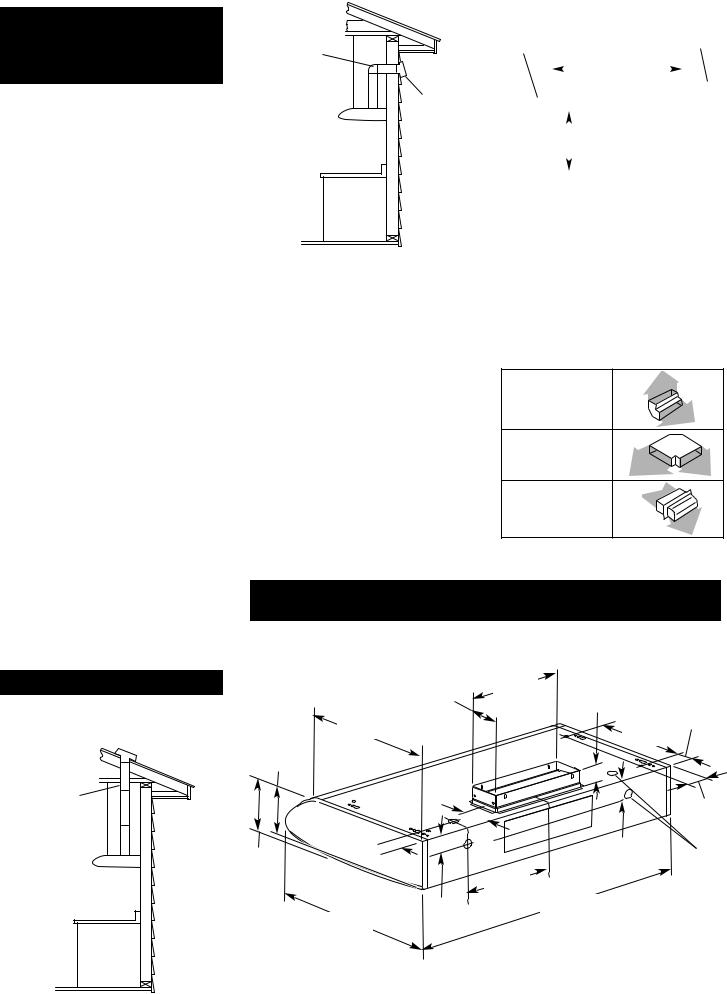
For vented models:
Vent system requirements
Do not terminate the vent system in an attic or other enclosed area.
Do not use 4" (10.2 cm) laundrytype wall caps.
Use metal vent only. Rigid metal vent is recommended. Do not use plastic or metal foil vent.
Flexible vent is not recommended. Flexible vent creates back pressure that greatly reduces the hood's performance.
•The size of the vent should be uniform.
•Use no more than three 90° elbows.
•Make sure there is a minimum of 24" (61 cm) of straight vent between the elbows if more than one elbow is used.
•Do Not install two elbows together.
•The length of vent system and number of elbows should be kept to a minimum to provide efficient performance.
•The vent system must have a damper. If roof or wall cap has a damper, Do Not use damper supplied with the range hood.
•Use duct tape to seal all joints in the vent system.
•Use caulking to seal exterior wall or roof opening around the cap.
Note: It is recommended that the vent system be installed before installing the hood.
Venting methods
Vent system needed for installation is not included. 3-1/4" x 10" (8.3 cm x 25 cm) rectangular is recommended.
3-1/4" x 10"
(8.3 cm x 25 cm) vent through the roof
Roof venting
3-1/4" x 10"
(8.3 cm x 25 cm) vent through the wall
wall cap
Wall venting
Recommended vent system length
Use 3 1/4" x 10" (8.3 cm x 25 cm) vent with maximum length of
26 feet (8 m) for vent system. For best performance, use no more than three 90° elbows. To calculate the length of system you need, add the equivalent feet (meters) for each vent piece used in the system. See the following example.
3-1/4" x 10" (8.3 cm x 25 cm) vent system
3-1/4" x 10” |
|
|
|
|
wall |
||||||||
(8.3 cm x 25 cm) |
|
|
|
|
|||||||||
|
|
|
|
cap |
|||||||||
90° elbow |
|
|
|
|
|||||||||
|
|
|
|
|
|||||||||
|
|
|
|
|
|
|
|
|
|
|
|
|
|
|
|
|
|
|
|
|
6 ft. (1.8 m) |
|
|
|
|||
|
|
|
|
|
|
|
|
|
|
||||
|
|
|
|
|
|
|
|
|
|
|
|
|
|
|
|
|
|
|
|
|
|
|
|
|
|
||
|
|
|
|
|
|
|
|
|
|
||||
|
|
|
|
|
|
|
|
|
|
|
|||
|
|
|
3 ft. |
|
|
|
|
|
|
||||
|
|
(0.93 m) |
|
|
|
|
|
|
|||||
|
|
|
|
|
|
||||||||
|
|
|
|
|
|
|
|
|
|
|
|
|
|
|
|
|
|
|
|
|
|
|
|
|
|
|
|
Maximum length |
= 26 ft. (8 m) |
||||||||||||
1 — 90° elbow |
= |
|
5 ft. |
(1.5 m) |
|||||||||
9 ft. (2.8 m) straight |
= |
|
9 ft. |
(2.8 m) |
|||||||||
1 — wall cap |
= |
|
0 ft. |
(0 m) |
|||||||||
Length of 3-1/4" x 10" |
|
|
|
|
|
||||||||
(8.3 cm x 25 cm) |
|
|
|
|
|
||||||||
system |
= 14 ft. |
(4.3 m) |
|||||||||||
Recommended standard fittings
3-1/4" x 10"
(8.3 cm x 25 cm) 90° elbow
= 5 ft. (1.5 m)
3-1/4" x 10"
(8.3 cm x 25 cm) flat elbow
= 12 ft. (3.7 m)
3-1/4" x 10"
(8.3 cm x 25 cm) wall cap
= 0 ft. (0 m)
Product dimensions
Note: Underside of hood must be a minimum of 24" (61 cm) from cooking surface.
3-3/16"
(8.1 cm)
13-3/8"
(34.0 cm)
4-3/4"
(12.1 cm)
2-9/16"
(6.5 cm)
1-3/16"
(3.0 cm) 
5-1/16"
(12.9 cm)
1-3/16"
17-3/4" (3.0 cm)
(45.1 cm)
9-15/16"
(25.2 cm)
1-9/16"
(4.0 cm)
2-11/32" 7-3/4" (6.0 cm)
(19.6 cm)
|
1-3/4" |
|
(4.4 cm) |
1-13/16" |
Do not |
(4.6 cm) |
|
|
use these |
9-27/32" |
knockouts |
(25.0 cm) |
|
30" (76.2 cm) 36" (91.4 cm)
Roof-vented model shown.
3
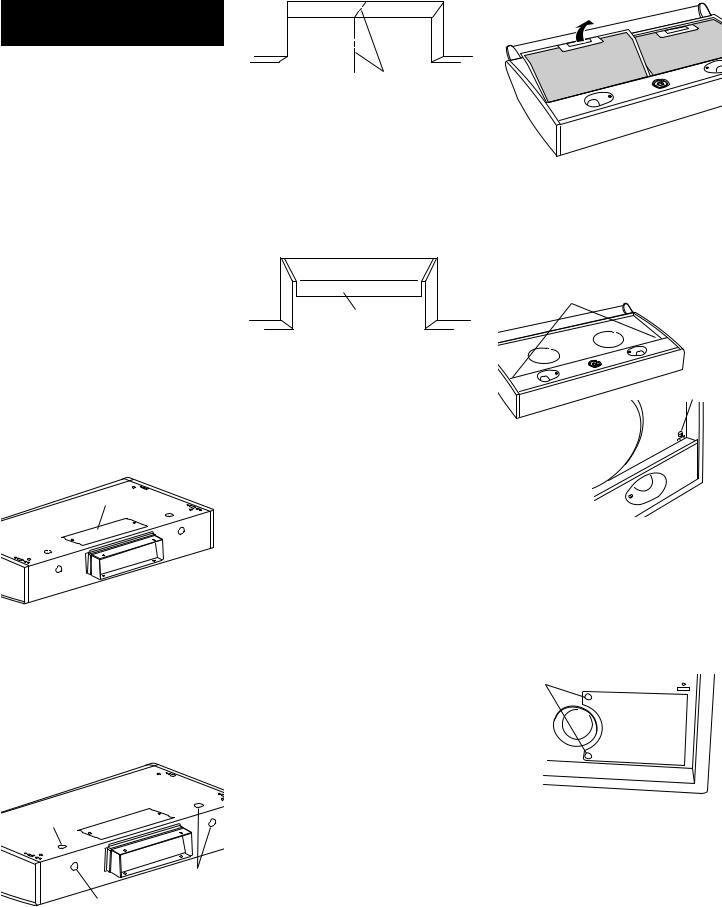
Now start...
1. Put a thick protective covering over cooktop, set-in range or countertop to protect from damage or dirt.
If installing over a freestanding range, disconnect and move the range to provide easier access to the upper cabinet and rear wall.
Slide range onto cardboard or hardboard before moving to prevent damaging floor covering.
2. Place hood on a protective cover with filters facing down.
3. Determine which venting method (roof, wall or non-vented) will be used.
•The hood is factory-set for roof venting.
•For non-vented installations, go to Step 4.
seal plate
 vent connection
vent connection
If venting through the wall, remove seal plate from back of hood and vent connector from top of hood. Reinstall vent connector onback of hood and seal plate on top of hood.
top knockout
do not use these
knockouts
back knockout
4. Remove knockout from the wiring opening (top or back) to be used.
4
centerlines
5. Mark centerlines on rear wall and upper cabinet bottom.
For non-vented installations:
Extend centerline up onto soffit above hood.
template |
6. Align centerlines of template with centerlines marked on rear wall and upper cabinet bottom. Tape template in place. Mark location of the four holes used to secure hood to upper cabinet.
7. Depending on your installation, mark location of the wiring hole or vent cutout in upper cabinet or back wall needed as shown on template.
8. Remove template.
9. Drill four 3/16" (5.0 mm) diameter holes through upper cabinet for the hood mounting screws.
10. Drill the 1-1/2" (4.0 cm) wiring hole.
11. Make the vent cutout for
3-1/4" x 10" (8.3 x 25.4 cm) rectangular vent system. Note: It is recommended that vent system be installed before installing hood.
12. Turn the hood over so filters face up.
13. Rotate deflector away from filters. Pull grease filter handles toward back of hood to release locking tabs. Lift filters up, remove from hood and set aside.
screw locations
screw
14. Remove 2 screws from light panel tabs. On light panel surface directly behind tabs, push toward back of the hood to move tabs out through the slots. Remove panel and set aside with screws.
remove screws
wiring box cover
15. Remove 2 screws from wiring box cover located in the right hand rear corner and remove cover. Attach the U.L.- or CSAlisted strain relief to the hood wiring hole being used.
16. Turn hood over so filters face down.
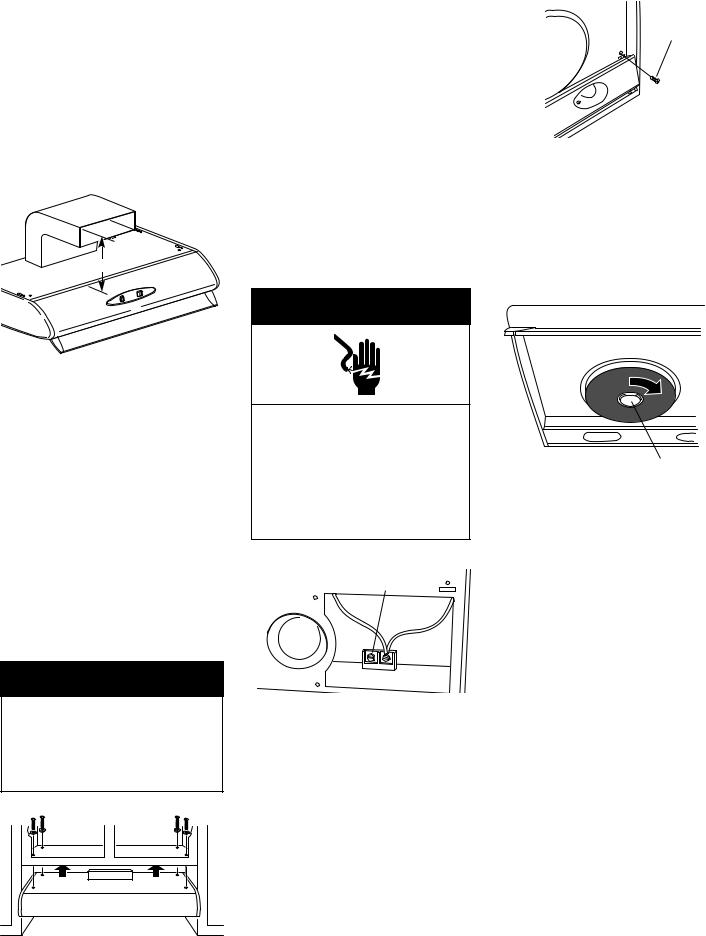
17. Attach hood damper into vent connector. Make sure that damper swings freely. If wall or roof vent system cap has a damper, DO NOT attach damper that came with hood.
Non-vented (recirculating) installations only: Assemble the vent system you will use over the roof vent opening but do not attach the vent system yet.
 A
A
Measure distance A and transfer it to the centerline on the soffit. Mark and cut a 3-1/4” x 10” (8.3 cm x 25 cm) vent opening in the soffit.
18. The hood is attached to cabinet bottom by four screws with washers inserted through cabinet bottom from inside of cabinet and into hood.
•If your cabinet has a frame around the bottom, use the four 2-3/4" (7 cm) long screws in parts bag.
•If your cabinet has a flush bottom (no frame), use the four shorter 2" (5.1 cm) long screws in parts bag.
 WARNING
WARNING
Excessive Weight Hazard
Use two or more people to move and install range hood.
Failure to do so can result in back or other injury.
19. Lift hood into place while feeding wiring into wiring box.
Feed enough wire into wiring box to easily make the connections and tighten the strain relief. Insert the four screws through cabinet bottom and into hood. Start screws into hood and tighten securely.
20. Connect the vent system.
Non-vented installations: Install the grille on the soffit.
Electrical connection
 WARNING
WARNING
Electrical Shock Hazard
Disconnect power before making electrical connections.
Connect ground wire to green ground screw in terminal box.
Failure to do so can result in death or electrical shock.
green ground screw
21. Connect the white and black wires of power supply cable to the white and black leads in hood with twist-on connectors.
Connect the power supply ground wire to the green ground screw inside hood’s terminal box.
Replace terminal box cover.
install screw
 tab
tab
22. Reinstall light panel. Insert light panel tabs into slots. Push in on back of light panel and insert the small tabs into the locating holes in back of the hood. Reinstall the 2 screws and tighten securely.
filter hub
23. Non-vented (recirculating) installations: Install the charcoal filters. Place filter over hub in blower openings, push up and turn clockwise to lock filter into place.
24. Install the aluminum grease filters.
5
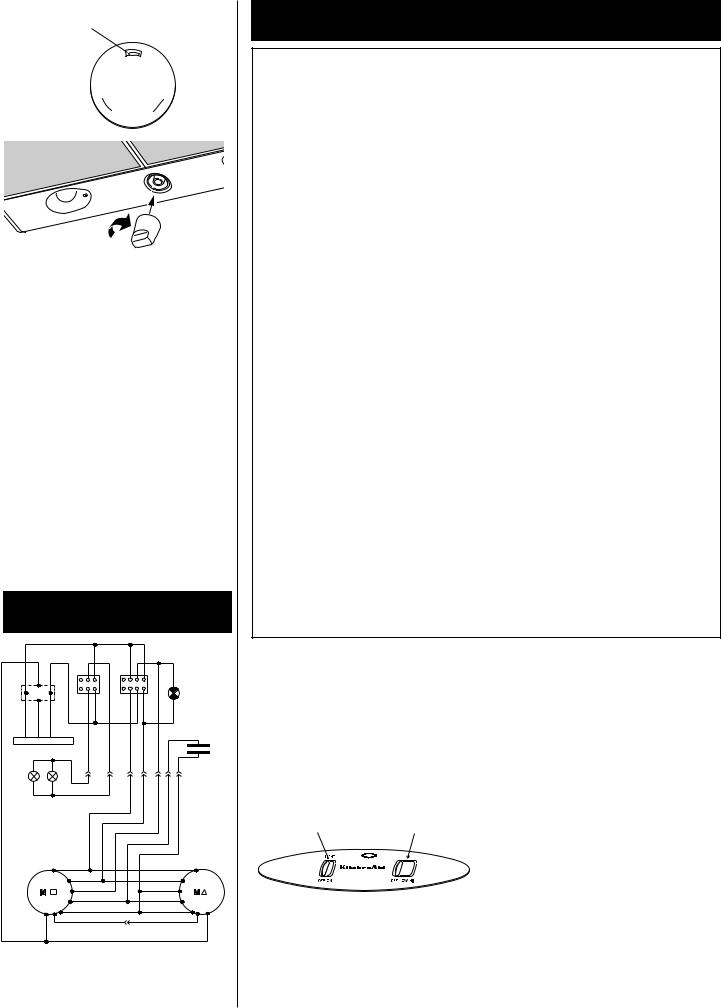
push tab toward center of cap
grease collection opening 
grease collection cup
25. Remove plastic cap located between lights. Locate tab in cap’s large slot. Use a small flat-bladed screwdriver and press tab toward center of cap to release tab. Squeeze cap to release other 2 tabs and discard cap.
Remove grease collection cup from the parts bag and twist cup clockwise into opening.
26. Turn power supply on.
Wiring diagram
|
|
|
WHT |
|
<![if ! IE]> <![endif]>BLK |
|
<![if ! IE]> <![endif]>BLK |
<![if ! IE]> <![endif]>BLK |
|
|
|
|
|
|
|
|
|
|
|
|
<![if ! IE]> <![endif]>WHT |
|
|
|
|
|
|
| <![if ! IE]> <![endif]>BOX |
<![if ! IE]> <![endif]>BLK |
<![if ! IE]> <![endif]>GRN |
<![if ! IE]> <![endif]>WHT |
<![if ! IE]> <![endif]>VLT |
|
|
|
|
|
|
|
|
|
| <![if ! IE]> <![endif]>WIRING |
<![if ! IE]> <![endif]>BLK |
<![if ! IE]> <![endif]>GRN |
<![if ! IE]> <![endif]>WHT |
<![if ! IE]> <![endif]>RED |
<![if ! IE]> <![endif]>WHT |
<![if ! IE]> <![endif]>VLT |
<![if ! IE]> <![endif]>BRW |
<![if ! IE]> <![endif]>WHT ORG |
|
|
|
|
|
|
120 VAC LINE IN 60 Hz |
|
|
|
|
|
|
|
|
|
|
||
|
|
RED |
<![if ! IE]> <![endif]>RED |
|
<![if ! IE]> <![endif]>VLT |
<![if ! IE]> <![endif]>BRW |
<![if ! IE]> <![endif]>ORG |
<![if ! IE]> <![endif]>WHT |
<![if ! IE]> <![endif]>BLU |
<![if ! IE]> <![endif]>GRY |
|
|
|
|
|
|
|
|
14 |
μF |
|||||||
|
|
|
|
RED |
|
<![if ! IE]> <![endif]>VLT |
<![if ! IE]> <![endif]>BRW |
<![if ! IE]> <![endif]>ORG |
<![if ! IE]> <![endif]>WHT |
<![if ! IE]> <![endif]>BLU |
<![if ! IE]> <![endif]>GRY |
|
|
|
|
|
VLT |
|
|
|
|
||||||
|
|
|
|
|
|
|
|
|
|
|
|
|
|
BRW |
BRW |
ORG |
ORG |
WHT |
WHT |
BLU |
BLU |
GRY |
GRY |
WHT |
WHT |
| <![if ! IE]> <![endif]>GRN |
<![if ! IE]> <![endif]>GRN |
6
Use and Care Information
WARNING — To reduce the risk of fire or electrical shock, do not use this fan with any solid-state speed control device.
WARNING — TO REDUCE THE RISK OF FIRE, ELECTRIC SHOCK, OR INJURY TO PERSONS, OBSERVE THE FOLLOWING:
Use this unit only in the manner intended by the manufacturer. If you have questions, contact the manufacturer. Before servicing or cleaning unit, switch power off at service panel and lock the service disconnecting means to prevent power from being switched on accidentally. When the service disconnecting means cannot be locked, securely fasten a prominent warning device such as a tag to the service panel
CAUTION: For general ventilating use only. Do not use to exhaust hazardous or explosive materials and vapors.
WARNING — TO REDUCE THE RISK OF A RANGE TOP GREASE FIRE:
Never leave surface units unattended at high settings. Boilovers cause smoking and greasy spillovers that may ignite. Heat oils slowly on low or medium settings.
Always turn hood ON when cooking at high heat or when cooking flaming foods.
Clean ventilating fans frequently. Grease should not be allowed to accumulate on fan or filter.
Use proper pan size. Always use cookware appropriate for the size of the surface element.
WARNING — TO REDUCE THE RISK OF INJURY TO PERSONS IN THE EVENT OF A RANGE TOP GREASE FIRE, OBSERVE THE FOLLOWING:
SMOTHER FLAMES with a closefitting lid, cookie sheet, or metal tray, then turn off the burner. BE CAREFUL TO PREVENT BURNS. If the flames do not go out immediately, EVACUATE AND CALL THE FIRE DEPARTMENT.
NEVER PICK UP A FLAMING PAN
— You may be burned.
DO NOT USE WATER, including wet dishcloths or towels — a violent steam explosion will result. Use an extinguisher ONLY if:
You know you have a Class ABC extinguisher, and you already know how to operate it.
The fire is small and contained in the area where it is started.
The fire department is being called.
You can fight the fire with your back to an exit.
Operation of range hood
For best results, turn range hood fan ON at beginning of cooking and allow it to run until all smoke and odors are removed from the room.
|
light |
fan |
|
|
|
|
|
|
|
|
|
To turn fan ON and OFF:
Slide fan control to turn fan on and off and adjust fan speed. Speed may be increased or decreased anytime during range hood operation.
To turn range hood light ON and OFF:
Slide light control to turn on or off. Light may be turned on or off anytime during range hood operation.
Deflector: When cooking will create a lot of smoke, use the deflector. The deflector will concentrate the venting action of the hood.
To use deflector, grasp from inside and pull down. Push up to return to its original position.
